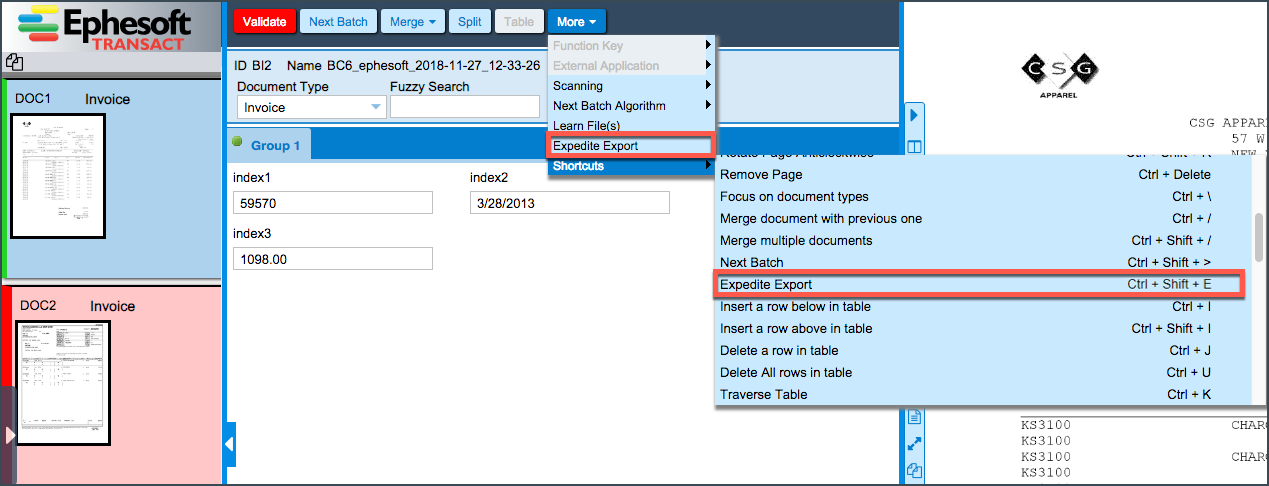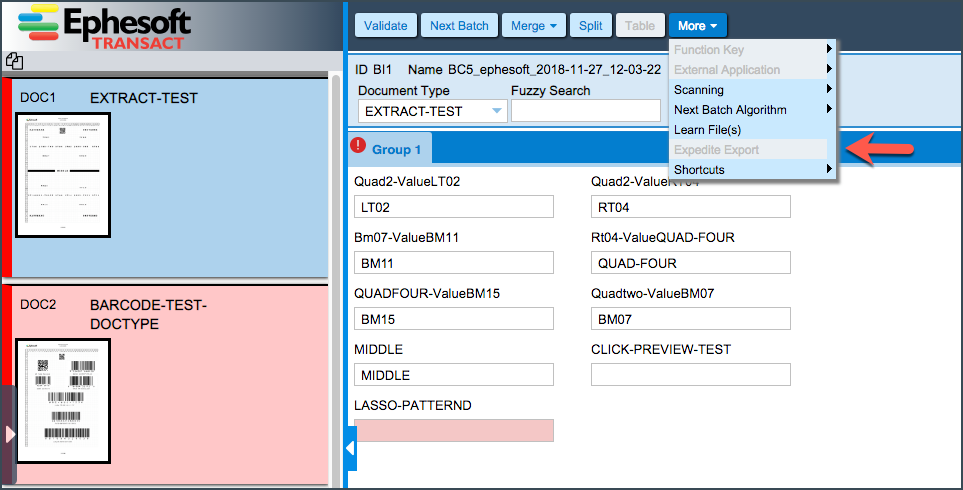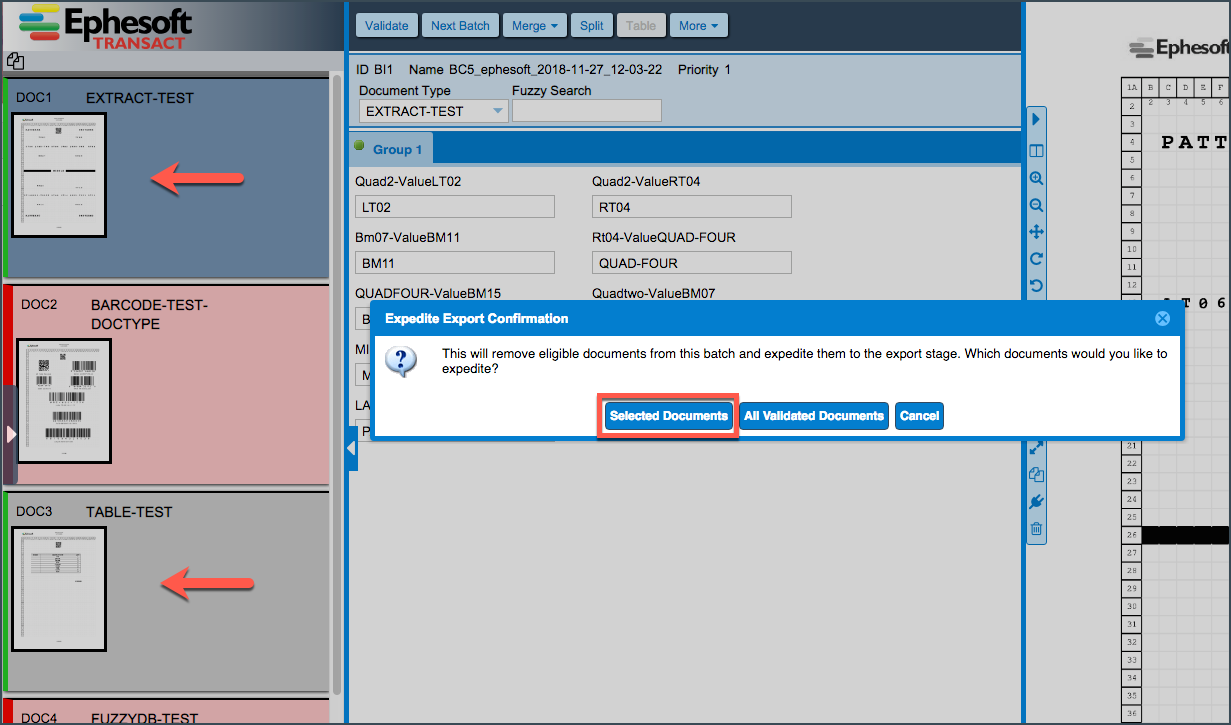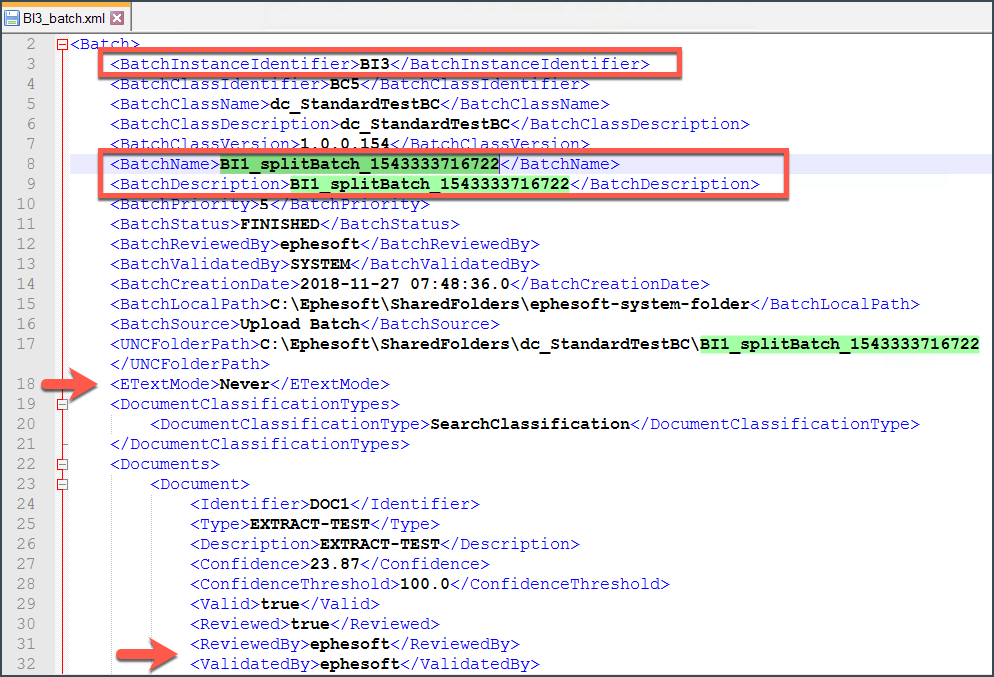Introduction
Typically, an operator is required to validate all documents in a batch to move the batch to the next step in the batch processing workflow. This includes documents with index fields whose extraction confidence scores fell below the specified confidence threshold and need to be validated manually, as well as documents whose index fields were extracted with confidence scores above the confidence threshold, which are considered “system validated”. In batches with large numbers of documents, this means that documents that have already been validated (either automatically validated by the system or manually validated by the user) will have to sit in the Validation phase of the workflow until every single document has been validated.
The “Expedite Export” feature allows the user to essentially “split” the batch and push one or more valid documents through to the next stage of the workflow (typically Export) without waiting for all of the documents in the batch to get validated. This essentially allows operators to locate and push through specific documents that may need to be processed more quickly or to move them through the system more efficiently. Once the selected documents are split into a new batch instance the system pushes this new batch through to the next step of the workflow (typically Export).
While the new batch is running, users can work with it like any other batch, except for a limitation on how the new batch can be restarted. If the user needs to restart the batch, the user can only restart it from the Folder Import or Export modules. After the new batch has been restarted from the Folder Import module and it begins to progress through the steps of the workflow, the batch can then be restarted from any module.
Expediting Export
The Expedite Export command can be found in the Validation screen drop-down menu. The command can also be executed with the Ctrl+Shift+E shortcut.

The Expedite Export command is enabled only if there are valid documents in a batch on the Validation screen. If none of the documents have been validated (all are marked in red), this command will be disabled.

When you select Expedite Export to move valid documents to the next workflow stage, the pop-up confirmation window is displayed with the following options:
- Selected Documents
- All Validated Documents
- Cancel

| Selected Documents | Creates a new batch instance which includes validated documents selected by the user, and moves it to the next stage of the workflow process.
To select several documents, simply press and hold the Ctrl key and click on the documents you wish to select. Note: This option is enabled only if all currently selected documents in the batch are valid (marked in green). |
| All Validated Documents | Creates a new batch instance which includes all valid documents (regardless of whether the user actually validated them individually or whether they were system validated), and moves it to the next stage of the workflow process. |
| Cancel | Cancels the operation and closes the confirmation window. |
Once a new batch is created with the selected validated documents, the following actions take place:
- A new batch is created in the database.
- All files related to the selected documents are moved to the ephesoft-system-folder\<Batch Instance ID> folder to create a new batch.
- The source files for the selected documents are copied to the drop folder as a new batch.
- A new batch.xml file is created for the split batch and the original batch.xml file is updated accordingly to remove references to the documents removed from that batch.
- The system creates a JSON file called “expedite_export.json” located in the \<Drop Folder>\backup folder with two parameters: “oldFileNames” and “expediteEvaluation”. These parameters are used by the system if the new batch ever has to be restarted by the user
-
- The “oldFileNames” parameter contains a semicolon-separated list of the old file names for each document in the new batch.
- The “expediteEvaluation” parameter indicates whether a document can be part of the expedited batch or not.
-
- The workflow for the new batch is started.
Consider the following example where batch BI1 contains five documents, with DOC1 and DOC3 already validated, and DOC2, DOC4 and DOC5 not yet validated. Let’s select DOC1 and DOC3 and use the Expedite Export feature in the Validation UI:
More drop-down menu -> Expedite Export option -> Selected Documents

Once we click Selected Documents, the two selected documents are removed from the current batch and a new batch instance is created, which is confirmed by the following message:

The original batch BI1 now contains only the remaining three documents: DOC2, DOC4 and DOC5.

The newly created BI3 batch is now displayed on the Batch Instance Management screen.

The naming convention used for the new batch name is as follows: <Original Batch Instance Id>_splitBatch_<unique numeric identifier>. In our case, the new batch instance name is BI1_splitBatch_1543333716722.
Note that the new batch inherits the priority of the original batch instance.
The newly created BI3 batch instance moves through the rest of the workflow configured for that batch class, and into the Export module. Its batch.xml file and the separated PDF files are stored in the final-drop-folder folder as usual (<Ephesoft Installation Directory>\SharedFolders\final-drop-folder). Note that the original document IDs are preserved (DOC1 and DOC3).

The batch.xml file for the new batch contains the usual batch.xml attributes, including the “ReviewedBy”, “ValidatedBy” and “ETextMode” parameters. Information about the source files is also included in the new XML file.

Restarting the Original or New Batch
If necessary, the original or new batch can be restarted as long as the current state of the batch is Running, Error, Ready for Review, or Ready for Validation.
The original batch can be restarted from any module available in its workflow. Note that it will contain only the remaining documents that weren’t moved into the new batch. In our earlier example, the original BI1 batch contained five documents before we created a new expedited batch for DOC1 and DOC3, so three documents remained. If we restart the original batch from the Folder Import module, there will be only three remaining documents displayed on the Validation screen, now numbered as DOC1, DOC2 and DOC3.

Initially, the newly created batch can only be restarted from two modules: Folder Import or Export. If the new batch is restarted from the Folder Import module and goes through the workflow from the beginning, the new batch can then be restarted from any module.
